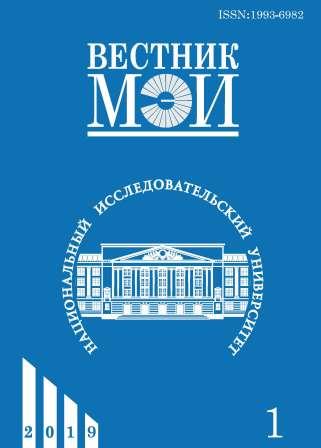Особенности реализации системы рационального управления составом агрегатов гидроэлектростанций и перспективы ее развития
DOI:
https://doi.org/10.24160/1993-6982-2019-1-98-107Ключевые слова:
оптимизация, рациональное управление, состав агрегатов, оценка состояния, групповое регулирование, эффективность, потенциальные потери, моделирование, распределение мощности, РУСА, проблемы рационального управления, перспективы рационального управления, гидроэлектростанцииАннотация
Рассмотрены основные положения по созданию системы оперативного рационального управления составом агрегатов на основе критериев повышения эффективности работы гидроэлектростанции (ГЭС) и безопасности работы агрегатов.
В основу расчета эффективности ГЭС заложен принцип потерь мощности агрегатов, определяемый по разнице вырабатываемой мощности и возможной, которая была бы выработана на том же объеме воды и при том же напоре при работе агрегата с оптимальным КПД. Критерий безопасности основан на сравнении параметров агрегата из системы АСУ ТП с моделью. Предпочтителен для изменения состояния агрегата с минимальным общим количеством отклонений от модели по всей ГЭС. Еще одна группа критериев ориентирована на равномерное распределение нагрузки на агрегаты: наработок, количества пусков–остановов, переходов через зоны ограниченной работы и т.д. Процесс принятия мультикритериального решения проиллюстрирован примером. Для оперирования составом выбран агрегат с учетом всех групп критериев, ранжированных с весовыми коэффициентами оператора.
Описана основная мнемосхема системы, при помощи которой оператор управляет составом. Проанализированы следующие проблемы реализации и перспективные направления дальнейших исследований:
- планирования изменения состава агрегатов в кратко-, средне- и долгосрочном периодах;
- оптимизации функции распределения мощности для систем группового управления, числа переключений в средне- и долгосрочной перспективах, критериев эффективности, безопасности и оценки состояния;
- дополнения модели расчетами реактивной мощности и потерями на трансформаторах;
- учета водных ресурсов и ограничений;
- предиктивной оценки состояния гидроагрегатов и ГЭС;
- объединения подходов системы рационального управления с системами энергоменеджмента основных потребителей электроэнергии;
- мотивации операторов;
- развития и построения полностью автоматической системы рационального управления составом агрегатов.
Реализация приведенных проблем полностью соответствует последним тенденциям Industry 4.0 в мире и может быть использована для построения умных производств энергетического сектора.
Библиографические ссылки
2. Кулабухов С.Ю. Дискретная математика. Шахты: Южно-Российский госуд. инст-т сервиса, 2006.
3. Веников В.А., Журавлев В.Г., Филиппова Т.А. Оптимизация режимов электростанций и энергосистем. М.: Энергоиздат, 1981.
4. Захарченко В.Е. Основной критерий автоматизированного рационального управления составом агрегатов ГЭС // Автоматизация в промышленности. 2017. № 9. С. 10—15.
5. Захарченко В.Е., Сидоров А.А. Оценка достоверности параметров контроля и управления АСУТП. Функционально-ориентированные модели. Lambert Academic Publ., 2012.
6. Уткин Л.В. Анализ риска и принятие решений при неполной информации. СПб.: Наука, 2007.
7. Захарченко В.Е., Сидоров А.А. Влияние функции распределения активной мощности на эффективность ГЭС // Автоматизация в промышленности. 2018. № 1. С. 29—33.
8. Усов С.В. и др. Электрическая часть электростанций. Л.: Энергоатомиздат, 1987.
9. Захарченко В.Е. Технико-экономическое обоснование автоматизированной системы рационального управления составом агрегатов ГЭС // Автоматизация в промышленности. 2017. № 11. С. 11—15.
10. ГОСТ Р ИСО 50001—2012. Системы энергетического менеджмента. Требования и руководство по применению.
11. Перфильева Е.Н. Повышение энергоэффективности горных предприятий на основе управления энергетическими ресурсами: дисс. … канд. техн. наук. М.: Московский гос. горный ун-т, 2007.
12. Кокшаров В.А. Комплексное управление перспективным энергопотреблением металлургических предприятий: дисс. …. доктора экон. наук. Екатеринбург: Уральский федер. ун-т им. первого Президента России Б.Н. Ельцина, 2016.
13. Страхова Н. А., Лебединский П.А. Имитационное моделирование как инструмент анализа энергоэффективности теплогенерирующих предприятий // Инженерный вестник Дона. 2013. Т. 4. № 4. С. 1—6.
14. Филиппова Т.А., Секретарев Ю.А. Учет эксплуатационного состояния при управлении составом агрегатов в АСУ ТП // Известия СОАН СССР. 1977. № 1. С. 132—136.
---
Для цитирования: Захарченко В.Е. Особенности реализации системы рационального управления составом агрегатов гидроэлектростанций и перспективы ее развития // Вестник МЭИ. 2019. № 1. С. 98—107. DOI: 10.24160/1993-6982-2019-1-98-107.
#
1. Urin V.D., Kutler P.P. Energeticheskie Harakteristiki dlya Optimizatsii Rezhima Elektrostantsiy i Energosistem. M.: Energiya, 1974. (in Russian).
2. Kulabuhov S.Yu. Diskretnaya Matematika. Shahty: Yuzhno-Rossiyskiy Gosud. Inst-t Servisa, 2006. (in Russian).
3. Venikov V.A., Zhuravlev V.G., Filippova T.A. Optimizatsiya Rezhimov Elektrostantsiy i Energosistem. M.: Energoizdat, 1981. (in Russian).
4. Zaharchenko V.E. Osnovnoy Kriteriy Avtomatizirovannogo Ratsional'nogo Upravleniya Sostavom Agregatov GES. Avtomatizatsiya v Promyshlennosti. 2017;9:10—15. (in Russian).
5. Zaharchenko V.E., Sidorov A.A. Otsenka Dostovernosti Parametrov Kontrolya i Upravleniya ASUTP. Funktsional'no-orientirovannye modeli. Lambert Academic Publ., 2012. (in Russian).
6. Utkin L.V. Analiz Riska i Prinyatie Resheniy pri Nepolnoy Informatsii. SPb.: Nauka, 2007. (in Russian).
7. Zaharchenko V.E., Sidorov A.A. Vliyanie Funktsii Raspredeleniya Aktivnoy Moshchnosti na Effektivnost' GES. Avtomatizatsiya v Promyshlennosti. 2018;1:29—33. (in Russian).
8. Usov S.V. i dr. Elektricheskaya Chast' Elektrostantsiy. L.: Energoatomizdat, 1987. (in Russian).
9. Zaharchenko V.E. Tekhniko-ekonomicheskoe Obosnovanie Avtomatizirovannoy Sistemy Ratsional'nogo Upravleniya Sostavom Agregatov GES. Avtomatizatsiya v Promyshlennosti. 2017;11:11—15. (in Russian).
10. GOST R ISO 50001—2012. Sistemy Energeticheskogo Menedzhmenta. Trebovaniya i Rukovodstvo po Primeneniyu. (in Russian).
11. Perfil'eva E.N. Povyshenie Energoeffektivnosti Gornyh Predpriyatiy na Osnove Upravleniya Energeticheskimi Resursami: Diss. … Kand. Tehn. Nauk. M.: Moskovskiy Gos. Gornyy Un-t, 2007. (in Russian).
12. Koksharov V.A. Kompleksnoe Upravlenie Perspektivnym Energopotrebleniem Metallurgicheskih Predpriyatiy: Diss. …. Doktora Ekon. Nauk. Ekaterinburg: Ural'skiy Feder. Un-t im. Pervogo Prezidenta Rossii B.N. El'tsina, 2016. (in Russian).
13. Strahova N. A., Lebedinskiy P.A. Imitatsionnoe Modelirovanie kak Instrument Analiza Energoeffektivnosti Teplogeneriruyushchih Predpriyatiy. Inzhenernyy Vestnik Dona. 2013;4;4:1—6. (in Russian).
14. Filippova T.A., Sekretarev Yu.A. Uchet Ekspluatatsionnogo Sostoyaniya pri Upravlenii Sostavom Agregatov v ASU TP. Izvestiya SOAN SSSR. 1977;1: 132—136. (in Russian).
---
For citation: Zakharchenko V.Е. Specific Features Pertinent to Designing a System for Rationally Managing the Composition of Hydro
Power Plant Units and Prospects for Its Further Development. MPEI Vestnik. 2019;1:98—107. (in Russian). DOI: 10.24160/1993-6982-2019-1-98-107.




